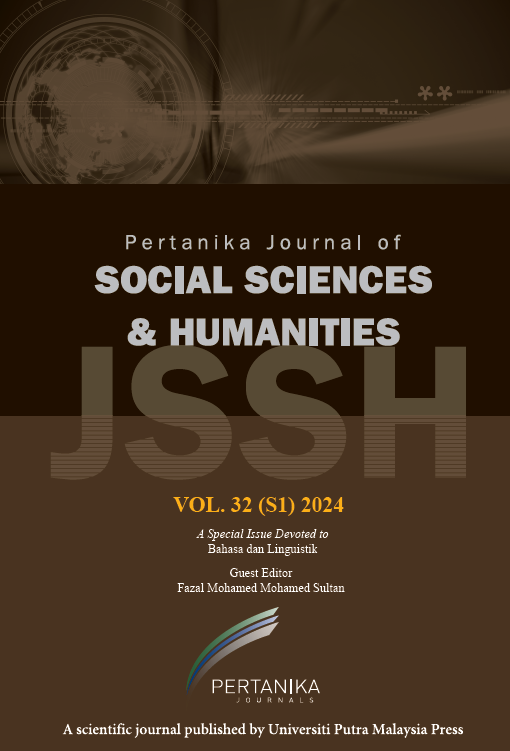PERTANIKA JOURNAL OF SOCIAL SCIENCES AND HUMANITIES
e-ISSN 2231-8534
ISSN 0128-7702
J
J
Pertanika Journal of Social Science and Humanities, Volume J, Issue J, January J
Keywords: J
Published on: J
J
-
Ali, R. A., Ibrahim, N. N. N., Ghani, W. A. W. A. K., Lam, H. L., & Sani, N. S. (2021). Utilization of process network synthesis and machine learning as decision-making tools for municipal solid waste management. International Journal of Environmental Science and Technology, 19, 1985-1996. https://doi.org/10.1007/s13762-021-03250-0
-
Ameram, N., Muhammad, S., Yusof, N. A. N., Ishak, S., Ali, A., Shoparwe, N. F., & Ter, T. P. (2019). Chemical composition in sugarcane bagasse: Delignification with sodium hydroxide. Malaysian Journal of Fundamental and Applied Sciences, 15(2), 232-236. https://doi.org/10.11113/mjfas.v15n2.1118
-
Baker, J. (2018). Biomass Conversion Technologies. BBJ Group. https://www.bbjgroup.com/blog/biomass-conversion-technologies
-
Bertok, B., & Heckl, I. (2016). Process synthesis by the p-graph framework involving sustainability. In G. Ruiz-Mercado & H. Cabezas (Eds.), Sustainability in the Design, Synthesis and Analysis of Chemical Engineering Processes (pp. 203-225). Elsevier. https://doi.org/10.1016/b978-0-12-802032-6.00009-8
-
Bufoni, A. L., Oliveira, L. B., & Rosa, L. P. (2016). The declared barriers of the large developing countries waste management projects: The star model. Waste Management, 52, 326-338. https://doi.org/10.1016/j.wasman.2016.03.023
-
Cabezas, H., Heckl, I., Bertok, B., & Friedler, F. (2015). Use the P-graph framework to design supply chains for sustainability. Chemical Engineering Progress, 111(1), 41-47.
-
Cleary, J. G., & Trigg, L. E. (1995). K*: An instance-based learner using an entropic distance measure. Machine Learning Proceedings 1995, 108-114. https://doi.org/10.1016/b978-1-55860-377-6.50022-0
-
Friedler, F., Tarjan, K., Huang, Y. W., & Fan, L. T. (1992). Combinatorial algorithms for process synthesis. Computers & Chemical Engineering, 16, S313-S320. https://doi.org/10.1016/s0098-1354(09)80037-9
-
Gupta, P., & Sinha, N. (2000). Neural networks for identification of nonlinear systems: An overview. In N. K. Sinha & M. M. Gupta (Eds.), Soft Computing and Intelligent Systems (pp. 337-356). Elsevier. https://doi.org/10.1016/b978-012646490-0/50017-2
-
Janke, L., Leite, A., Nikolausz, M., Schmidt, T., Liebetrau, J., Nelles, M., & Stinner, W. (2015). Biogas production from sugarcane waste: Assessment on kinetic challenges for process designing. International Journal of Molecular Sciences, 16(9), 20685-20703. https://doi.org/10.3390/ijms160920685
-
Kiatkittipong, W., Wongsuchoto, P., & Pavasant, P. (2009). Life cycle assessment of bagasse waste management options. Waste Management, 29(5), 1628-1633. https://doi.org/10.1016/j.wasman.2008.12.006
-
Kulkarni, E. G., & Kulkarni, R. B. (2016). WEKA powerful tool in data mining. International Journal of Computer Applications, 975, 10-15.
-
Landwehr, N., Hall, M., & Frank, E. (2003). Logistic model trees. Machine Learning: ECML 2003, 241-252. https://doi.org/10.1007/978-3-540-39857-8_23
-
Lee, R. P., Meyer, B., Huang, Q., & Voss, R. (2020). Sustainable waste management for zero waste cities in China: potential, challenges and opportunities. Clean Energy, 4(3), 169-201. https://doi.org/10.1093/ce/zkaa013
-
Monteiro, S. N., Candido, V. S., Braga, F. O., Bolzan, L. T., Weber, R. P., & Drelich, J. W. (2016). Sugarcane bagasse waste in composites for multilayered armor. European Polymer Journal, 78, 173-185. https://doi.org/10.1016/j.eurpolymj.2016.03.031
-
Naik, A., & Samant, L. (2016). Correlation review of classification algorithm using data mining Tool: WEKA, Rapidminer, TANAGRA, Orange and KNIME. Procedia Computer Science, 85, 662-668. https://doi.org/10.1016/j.procs.2016.05.251
-
Negnevitsky, M. (2011). Artificial Intelligence: A Guide to Intelligent System (3rd ed.). Pearson Education.
-
Puna, J., & Teresa, M. (2010). Thermal conversion technologies for solid wastes: A new way to produce sustainable energy. In E. S. Kumar (Ed.), Waste Management (pp. 129-154). InTech. https://doi.org/10.5772/8461
-
Sangalang, K. P. H., Belmonte, B. A., Ventura, J. R., Andiappan, V., & Benjamin, M. F. D. (2021). P-graph method for optimal synthesis of Philippine agricultural waste-based integrated biorefinery. Chemical Engineering Transactions, 83, 103-108.
-
ttps://doi.org/10.3303/CET2183018
-
Sidana, A., & Farooq, U. (2014). Sugarcane bagasse: A potential medium for fungal cultures. Chinese Journal of Biology, 2014, 1-5. https://doi.org/10.1155/2014/840505
-
Sindhu, R., Gnansounou, E., Binod, P., & Pandey, A. (2016). Bioconversion of sugarcane crop residue for value added products - An overview. Renewable Energy, 98, 203-215. https://doi.org/10.1016/j.renene.2016.02.057
-
Tin, Y. T., Kean, T. T., Hui, C. K., Ponniah, G. D., & Loong, L. H. (2017). Debottlenecking of the Integrated Biomass Network with Sustainability Index in Malaysia. The Journal of The Institution of Engineers, Malaysia, 78(1), 22-26. https://doi.org/10.54552/v78i1.15
-
Varbanov, P. S., Friedler, F., & Klemeš, J. J. (2017). Process network design and optimisation using process graph: The success, the challenges and potential roadmap. Chemical Engineering Transaction, 61, 1549-1554. https://doi.org/10.3303/CET1761256
-
Witten, I. H., Frank, E., Hall, M. A., & Pal, C. J. (2017). Data Mining: Practical Machine Learning Tools and Techniques (4th ed.). Morgan Kaufmann.
ISSN 0128-7702
e-ISSN 2231-8534
Recent Articles




